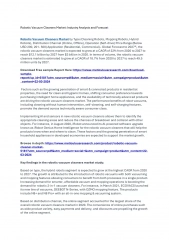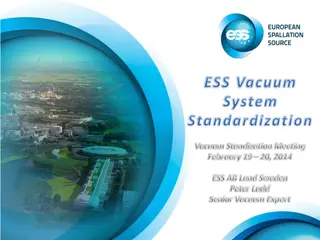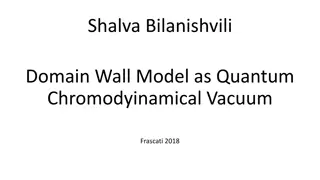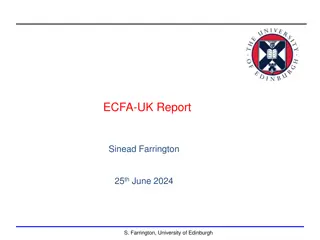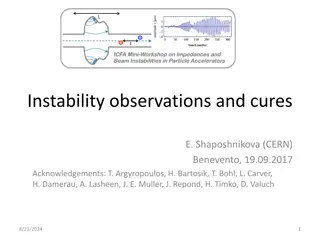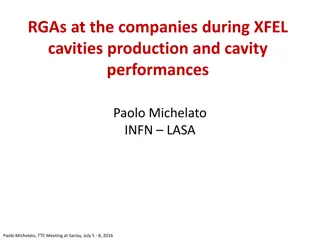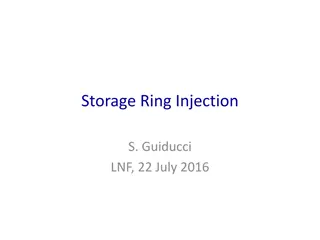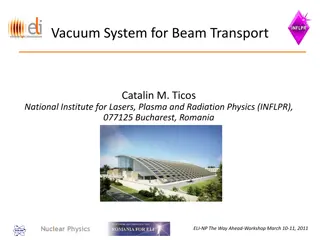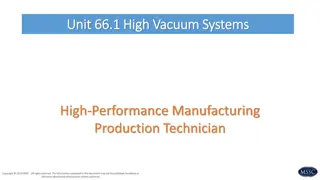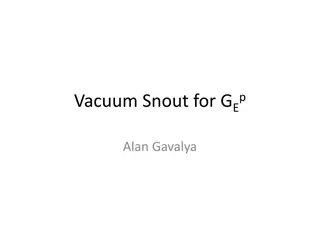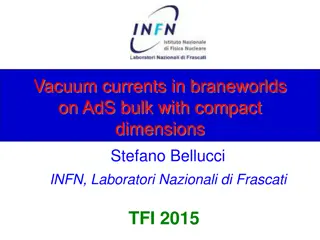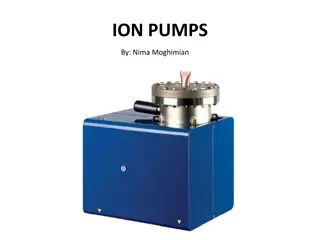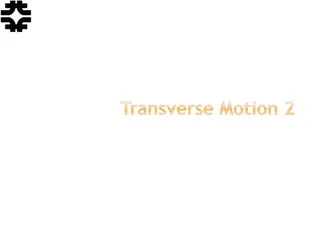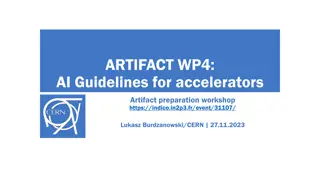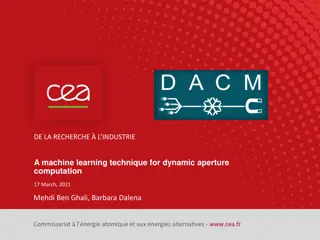Vacuum Technology for Particle Accelerators
This presentation covers the importance of vacuum technology in particle accelerators, focusing on particle loss due to collisions with residual gas molecules and the stringent vacuum requirements for storage rings and accelerators. It discusses the impact of circulating beams on vacuum deterioration and emphasizes the need for careful surface cleaning to prevent beam loss. The lecture also highlights historical vacuum pump developments and specific accelerator examples like the CERN Intersecting Storage Rings (ISR). Overall, the talk provides valuable insights into maintaining optimal vacuum conditions in accelerator systems.
Uploaded on Sep 16, 2024 | 0 Views
Download Presentation

Please find below an Image/Link to download the presentation.
The content on the website is provided AS IS for your information and personal use only. It may not be sold, licensed, or shared on other websites without obtaining consent from the author.If you encounter any issues during the download, it is possible that the publisher has removed the file from their server.
You are allowed to download the files provided on this website for personal or commercial use, subject to the condition that they are used lawfully. All files are the property of their respective owners.
The content on the website is provided AS IS for your information and personal use only. It may not be sold, licensed, or shared on other websites without obtaining consent from the author.
E N D
Presentation Transcript
Vacuum technology for particle accelerators C. Benvenuti, CERN (honorary staff member) Cogne meeting, February 2020 1
Lesson 1: Introduction The Intersecting Storage Rings (ISR) Lesson 2: Getter pumping The Large Electron Positron collider (LEP) The Large Hadron Collider (LHC) An alternative solution Conclusions Cogne meeting, February 2020 2
Otto von Guerickes first pneumatic vacuum pump (1654) Cogne meeting, February 2020 3
von Guerickes second vacuum pump (1657) Cogne meeting, February 2020 4
Introduction Particles circulating in accelerators may get lost by electronic and nuclear collisions with the residual gas molecules The particle loss depends on the interaction cross sections for the different gases and on gas densities The vacuum requirements are more stringent for storage rings, where the particles are kept circulating for hours or days, than for accelerators, where the particles are extracted after a few revolutions In the first case, an operating pressure of 10-9 or 10-10 Torr is mandatory, while in the second case 10-6 or 10-7 Torr is sufficient ( 1 Torr= 133 Pa) Cogne meeting, February 2020 5
The circulating beams deteriorate the initial (static) vacuum via various processes In electron machines, the produced synchrotron radiation releases gases by hitting the vacuum chamber surfaces In proton machines, the degassing is due to surface bombardment by charged particles produced and accelerated by the beam potential Degassing may trigger a positive feedback process, which may result in beam loss Careful surface cleaning is mandatory! Cogne meeting, February 2020 6
2. The CERN Intersecting Storage Rings (ISR) The ISR was the world s first hadron collider Fig.1. The ISR layout. Cogne meeting, February 2020 7
The machine consisted of two tangential rings of about 300 m diameter, with 8 intersections for proton-proton collisions, surrounded by detectors The energy of the (continuous) beams was 25 -28 GeV, and the final beam intensity was more than 30 A Cogne meeting, February 2020 8
2.1. The ISR vacuum Initially, pumping was done by means of mechanical rotary pumps and turbomolecular pumps, followed by sputter-ion pumps (350 units, each with a pumping speed of about 350 l s-1) The achieved pressure was in the 10-10 Torr range, an order of magnitude better than specified. However, in the presence of circulating beams, the vacuum was spoilt by pressure bumps , due to ion bombardment of the vacuum chamber surfaces. This severely limited the beam current. The problem was cured by adding about 700 Titanium sublimation pumps, and a careful surface cleaning by use of an Argon-Oxygen plasma followed by in-situ baking at 300 C After these improvements, average pressure was in the low 10-12 Torr Cogne meeting, February 2020 9
The operating principles of the sputter-ion pump (and of the titanium sublimation) pumps are illustrated in the figure below (Fig. 2) Fig. 2. Schematic view of the sputter-ion pump. Cogne meeting, February 2020 10
The pump consists basically of two Ti (or Ti-Ta) plates at ground potential (cathodes) in an external magnetic field (of the order of 1000 gauss). A glow discharge is triggered by applying a positive potential (typically 5 kV) to an array of small cylinders, where the electrons ionize the residual gas. The ions repelled by the positive potential bombard the Ti plates and extract Ti atoms, which produce a pumping coating on the surrounding surfaces. The function of the magnetic field is to provide the electrons inside the cylinders with cyclotron orbits, which increase the electron ionisation efficiency and allow maintaining the discharge at very low pressures. Cogne meeting, February 2020 11
In the titanium sublimation pump, titanium is sublimated from a filament heated at about 800 C. A chemically reactive film is produced, which traps the gas molecules until finally is saturated. To restore pumping, the sublimation process must be repeated. Cogne meeting, February 2020 12
2.2 Measurement of pressure at the ISR The initial pressure of 10-10 Torr was measured using 350 ionization pressure gauges of the Bayard-Alpert (B-A) type. After the ISR vacuum improvement, these gauges became inadequate and a better gauge was needed. Cogne meeting, February 2020 13
The B-A gauge, developed in the 1950s, had improved the low pressure measuring limit by two orders of magnitude, but, according to Alpert himself (Encyclopaedia of Physics, Springer-Verlag, vol. 12, 624, 1958) it could not be used for pressures in the 10-12 Torr range, such as those achieved in the ISR. Other gauges could have been chosen, but, in this case, not only the gauge heads, but also the power supplies would have had to be replaced, with an important additional cost. It was therefore decided to carefully analyse the causes of this apparent low- pressure limitation, hoping to make the B-A gauge compatible with the new measuring requirements. Cogne meeting, February 2020 14
Fig 3 shows the standard design of the B-A gauge. Electrons are emitted by heating a tungsten filament at about 2000 C and are accelerated by the grid (kept at a positive potential about 150V higher than that of the filament). Since the grid is quite transparent , before landing on the grid the electrons cross the grid volume a few times and produce ions, which are then collected by the central collector. The resulting ion collector current is proportional, for a given gas, to the gas density (pressure). Cogne meeting, February 2020 15
Fig. 3. Bayard-Alpert pressure gauge. Cogne meeting, February 2020 16
This process looks very simple, but there is a problem. By hitting the grid, the electrons produce x-rays, some of which reach the ion collector and extract photoelectrons. An electron current leaving the collector mimics a current of collected ions and the collector current does not correspond any more to the gas density to be measured. Since the X-Ray current is pressure independent, the problem becomes particularly serious when the pressure becomes very low. Although the X-Ray current could be reduced by thinning the collector, below a certain thickness, Alpert claimed, the ion collection efficiency would be equally reduced, and the benefit of a very thin collector would be lost. The development work carried out at the ISR showed that this statement is wrong. Cogne meeting, February 2020 17
Triangles: open grid Dots: closed grid Fig. 4. B-A gauge sensitivity as a function of the diameter of the ion collector. Cogne meeting, February 2020 18
In fact, the ion collection efficiency remains constant even for very thin collectors, provided the grid is properly closed. In this case, the ions cannot escape, and finally they are collected. The B-A gauge was further improved by enlarging the grid diameter (from typically 25 mm to 36mm). A larger grid increases the ions production (longer path inside the grid volume) and further reduces the X-Ray current (larger grid to collector distance). Thanks to this work, about 500 B-A gauges able to measure 10-12 Torr were purchased and 350 of them were installed in the ISR. Cogne meeting, February 2020 19
2.3 Pumping the ISR intersections To reduce the background in the experiments, pressures of 10-13 or even lower were requested for vacuum pipes at the ISR intersections At that time (1960s) it was generally believed that these extreme pressures could only be achieved by cryo-pumping (i.e. by condensing the residual gases on a surface kept at liquid helium temperature) However, studies carried out at CERN and in other laboratories showed an unexpected limitation of hydrogen vapour pressure, which could not be decreased to below 10-10 Torr, irrespective of the condensation temperature. Cogne meeting, February 2020 20
Fig. 5. The measured hydrogen vapour pressure. Cogne meeting, February 2020 21
The influence of the condensing surface material was explored at CERN by means of a dedicated cryostat to allow its easy replacement (see Fig.6). Fig. 6. Test cryostat. Cogne meeting, February 2020 22
The result of this study clearly showed that the anomalous vapour pressure only depends on the total amount of thermal radiation absorbed, and not on other properties of the tested materials (see Fig. 7) Fig. 7. Influence of the condensing surface on the hydrogen pressure. Cogne meeting, February 2020 23
The reason for the anomalous hydrogen behaviour was found to be a special property of this particular element. Hydrogen is the only existing material for which the Debye phonon (the highest energy phonon in any given material) carries more energy than needed to desorb a molecule. The absorbed radiation produces phonons in the underlying surface. These phonons are transmitted to the hydrogen condensate, which allows Debye phonons to reach the hydrogen surface and desorb molecules. All gases heavier than hydrogen have lower energy Debye phonons. Therefore, a few monolayers of nitrogen or argon interposed between the metal surface and the hydrogen film will prevent the transmission of the detrimental phonons and remove the hydrogen vapour pressure anomaly. This effect was confirmed experimentally, opening the way to ISR applications. Cogne meeting, February 2020 24
2.4 Cryopumping applications for the ISR A important practical consequence of the described study was to minimize the radiation load onto the condensation surface which also served to decrease the consumption of liquid He. This resulting design is shown in Fig. 8 Cogne meeting, February 2020 25
The cryo-surface is shielded by a chevron baffle cooled by liquid nitrogen and coated by an infrared black film, so as to transmit less than 10-3 of the room temperature thermal radiation. The cryo-surface is silver coated, to reflect about 99% of the transmitted radiation. Fig. 8. Design of the ISR cryo-pump. Cogne meeting, February 2020 26
Two large cryo-pumps were installed at ISR intersection 6 (Fig. 9), where they produced a vacuum of about 2x10-13 Torr. Fig. 9. Cryo-pumps in the ISR. Cogne meeting, February 2020 27
One of these cryo-pumps is shown in Fig. 10, during its assembly. Fig. 10. Cryo-pump during assembly. Cogne meeting, February 2020 28
Four smaller cryo-pumps of this type were also installed at ISR intersection 8. A practical problem with cryopumping is that the liquid helium should be periodically refilled, and this can disturb the machine operation. For the cryopump model shown in Fig. 8, operation without helium refilling was possible for two weeks, but a longer time interval would have been preferred. For this reason the cryopump design was modified by adding an external shield connected to the liquid helium exhaust pipe and cooled by the recovered cold gas (see Fig. 11). The new design was adopted for the 4 smaller cryo-pumps which were installed at intersection 8 (see Fig. 12). In this case, 11 litres of liquid helium provided undisturbed operation for 200 days. Cogne meeting, February 2020 29
Low loss cryo-pump design, with an external shield connected to the liquid helium exhaust pipe. Fig. 11. Low loss cryo-pump. Cogne meeting, February 2020 30
Small cryostat with reduced helium consumption. Fig. 11. Small low-loss cryostat. Cogne meeting, February 2020 31
Installation for testing the cryo-pumps to be installed at ISR point 8. Fig. 13. Setup for testing the cryo-pumps for intersection 8. Cogne meeting, February 2020 32
2.5 Pressure measurements for the ISR intersections Due to the intrinsic X-ray limitation of the B-A gauge, various alternative designs had been proposed and developed in many laboratories. The common feature of these designs was an ion collector external to the grid volume, so as to be less exposed to the detrimental X-rays. The ions were then driven to the collector by electric fields. An example of the external collector gauge is given in Fig. 14. Cogne meeting, February 2020 33
Fig. 14. Schematic view of an external collector gauge. Cogne meeting, February 2020 34
Among the gauges of this type commercially available, a model developed by Helmer was equipped with a power supply allowing measurements down to 10-13 Torr . In this gauge the ions extracted from the grid are deflected by an electrostatic field so as to reach a fully shielded collector (see Fig. 15). Fig. 15. Diagram of a Helmer gauge. Cogne meeting, February 2020 35
However, the extremely low pressures achieved for the ISR revealed another, unexpected, limitation in the low 10-12 Torr range, due to sublimation of tungsten atoms from the gauge filament at the operating temperature of 2000 C. By coating the filament with thoria it was possible to decrease this temperature to about 1000 C , which removed this limitation (see Fig. 15). The gauge sensitivity was then increased by enlarging the grid diameter, and with this improved Helmer gauge it became possible to measure down to the low 10-14 Torr range, the lowest pressure ever measured to this day. Fig. 15. Improved Helmer gauge. Cogne meeting, February 2020 36
In Fig. 16 we see the evolution of ultimate achieved vacuum from 1900 to the present day. References to experiments are as follows: - Gaede (1905, 1913); - Sherwood ((1918); - Bayard and Alpert (1950); - Venema (1958); - Davis (1962); - Hobson (1964); - Benvenuti ( 1977, 1979, 1993). Fig. 16. Plot of achieved vacuum vs. time. Cogne meeting, February 2020 37


